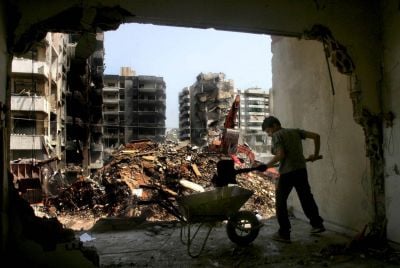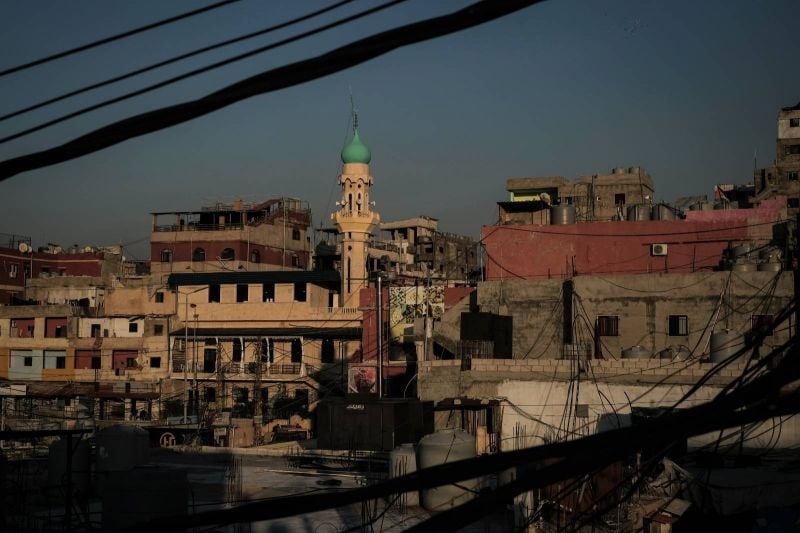
Haret Hreik, part of Beirut’s chaotic suburban sprawl. (Credit: João Sousa/L’Orient Today)
HARET HREIK, Baabda — Looking out the window of his office in the Haret Hreik municipality building, Mustapha Qomati recalled the view of the same street when he was a boy.
“This area here that you are seeing if you look out the window, you would have found it all green, all of it orange groves,” said Qomati. At 78, having been born and raised in Haret Hreik and working for the past 50 years as a developer and municipal engineer, he has had a front row seat to the changing landscape.
“There was the church. It was small at the time. There was the church, and there was a cemetery. … In the beginning the tallest buildings were one floor. Every house was one floor and had a garden next to it. It’s known, [Haret Hreik] was beautiful.”
The church, named for St. Joseph, is still there. Apart from that, the view has changed completely. Today, rows of high-rise apartment buildings cut off the view of the horizon. On the street level, it’s a middle-class commercial district, packed with shops selling clothes, books and electronics.
The scene is a far cry from the pastoral paradise people of Qomati’s generation remember, but also far from the dystopian images conjured up by the tagline that frequently accompanies mentions of the area in media reports, including after the deadly bombings that hit Beirut’s southern suburbs between 2013 and 2015 and then in reports on the Feb. 4 assassination of anti-Hezbollah activist and Haret Hreik resident Lokman Slim: “Hezbollah stronghold.”
The reality is more complex.
Demographic changes
Before the 1975-90 Civil War, Haret Hreik was a majority-Christian community; President Michel Aoun was born there in 1933.
The church that stands today was built in 1950, replacing a smaller church built in the 19th century, parish priest Issam Ibrahim told L’Orient Today. Ibrahim began leading services at the church in 1982 and continued until 1985, when militants came in and torched the pews.
Despite a series of armed groups occupying it after that, the church survived the war without structural damage. In 2000, after a renovation, it reopened for services.
“We don’t have any pictures of [the old one],” Ibrahim said. “I’ve asked many people. But they say it was a beautiful church built in 1860. They wanted to build a big church and they made the mistake to destroy the old one.”
Even before the war, the area had some Shiite residents, like Qomati and like Salma Harb, who moved to Haret Hreik as a young bride in the mid-1960s because her husband’s family owned property there. She recalled an idyllic time when she could push a stroller down the airport road under the shade of pine trees.
“The church was not far from us, and they would celebrate all the [Christian] holidays, and we would meet each other in the shops when we would go out and greet each other in the street, because at the time one could walk everywhere,” Harb said.
The urbanization of the area began a few years before the Civil War, Qomati recalled. But it was after the outbreak of conflict in 1975 that Christians began to sell their houses and leave en masse. They were replaced by Shiite families fleeing the conflict in south Lebanon or from Beirut neighborhoods like Nabaa that had come under the control of Christian militias.
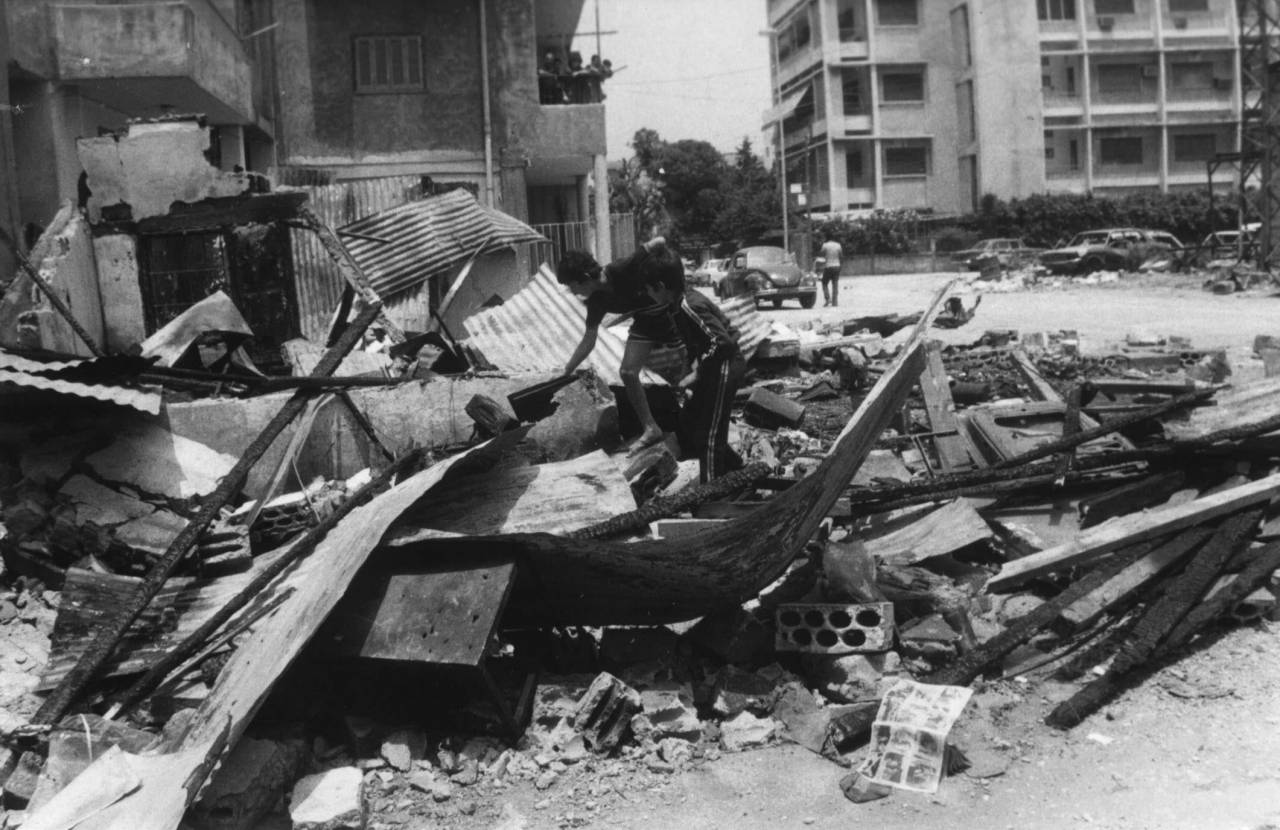 Boys explore a pile of rubble in Haret Hreik during the Civil War. (Credit: OLJ archives)
Boys explore a pile of rubble in Haret Hreik during the Civil War. (Credit: OLJ archives)
“When there began to be displacement and fighting between east and west [Beirut], there began to be division of the population along demographic lines,” Qomati said. But he added, “The Christians sold their land — it’s not like people say that they were chased out. To the contrary, we were living together.”
He pointed out that until the present day, the mayor of Haret Hreik is always a Christian.
Current Mayor Ziad Waked, in office since 2010, told L’Orient Today that while he had left with his family in the 1980s, other Christians had remained in Haret Hreik through the Civil War and left only after the Israeli bombing campaign of 2006 destroyed their houses.
“There were [Christians] who stayed for quite a while. Now there are very few, but about 20 years ago, they fixed the church up and people started coming to the church on Sunday,” he said. “In the end, they don’t forget their roots, which are in Haret Hreik.”
Perhaps 150 people attend mass on a typical Sunday and as many as 2,000 on major holidays like St. Joseph’s Feast, Ibrahim said. To this day, he said, many of the former Christian residents are hoping to move back to the area, but he added that they would not do so under the current circumstances.
“When there are no more weapons in Lebanon and there is a state, they would like to return to Haret Hreik, and I’m ready to build 200 houses on land [there],” he said. “We can build them, but we want peace and we want a state.”
Still, he said, for his congregation, “From 2000 to now there has never been a single problem with the Muslims, the Shiites or with Hezbollah.”
The making of a modern Shiite metropolis
As new residents flocked to Haret Hreik in the early years of the Civil War, a small group of Shiite developers began reshaping the area into a modern metropolis with office buildings, malls and movie theaters.
“Between 1978, 1979 and the early ’80s up to maybe 1983, Haret Hreik became this place of real experimentation for many of the Shiite low-income guys who had who had flocked from the eastern suburbs via a couple of years in the Gulf or something like this [where they had] made a little bit of money,” Mona Fawaz, a professor of urban studies and planning at the American University of Beirut told L’Orient Today. “And when they come back, Haret Hreik has lost a lot of its residents, and there’s land for sale.”
As a result, Haret Hreik became a place of “empowerment, of modernization” for the Shiite community, Fawaz said. With enforcement of building regulations being lax at the time, she noted, “They built, exceeding building permits by a lot — they did a lot of infractions, but they became the developers. … These guys were not Hezbollah, they were modernists.”
However, some of the old residents were not happy with the form the modernization was taking.
“All the houses ended up being on top of each other, and you didn’t know where you were coming from or going,” Harb recalled. “You started to feel that this was something that wasn’t the Haret Hreik you used to know with the people who were present from before.”
After sticking out most of the Civil War in Haret Hreik, Harb’s family left for Beirut in 1989. Their house had been hit in the intra-Shiite fighting that broke out in the late 1980s between the Amal Movement and the new upstart Shiite power, Hezbollah.
Harb said even so, the family might have stayed had her children not been attending university at the American University of Beirut, located in the northwest corner of the capital.
“I didn’t want them going through checkpoints to get there — there were some set up by the militias, some by the army and different groups,” she recalled. (In a cruel irony, upon relocating, their house in Verdun was also hit amid fighting between forces led by Michel Aoun and the Syrian army.)
A ‘Hezbollah stronghold’?
In the aftermath of the Civil War, Haret Hreik underwent another building boom. The rush to build was fueled by anticipation of a law — eventually passed in 1994 — that would allow for legalization of buildings previously constructed in violation of building codes, Fawaz said.
“Immediately after the Civil War, if you look at the building permit records, you see that the developers built galore,” she said. In many cases, they built higher and more densely than the law allowed.
Meanwhile, in the political sphere, Hezbollah had emerged from the Civil War as the dominant player in Beirut’s southern suburbs, commonly called Dahieh, establishing its headquarters in Haret Hreik.
Farah Nasrallah, a 35-year-old English teacher and graduate student living in Haret Hreik, recalls growing up with her family home within Hezbollah’s “security square.” She and her siblings were used to passing through gates to go in and out of the neighborhood and to the presence of armed men standing guard on the street below their house.
Nasrallah’s father had opened a commercial sign shop on the street in the early 1990s, but business went downhill after the April 1996 “Grapes of Wrath” war in which Israel bombarded Haret Hreik, which both prompted Hezbollah to further tighten security and scared outsiders away, she recalled.
“People were afraid just to go into this place — it was all closed off during that period of time,” she said.
Another issue was that her father was an Amal supporter in a Hezbollah area, making their presence not entirely welcome.
“They couldn’t throw him out because we own the house — we owned it before they even existed — but the business downstairs stopped working and he went to another area to be able to do his business there,” she said.
Despite the strictures, non-Hezbollah actors were able to carve out space in Haret Hreik.
In 2005, Slim — who came from one of the prominent old Shiite families in the area — and his wife, Monika Borgmann, opened the “Hangar,” an event space that hosted exhibitions, discussions and film screenings. The couple had also founded Umam Documentation & Research, an association dedicated to preserving the history of the Civil War.
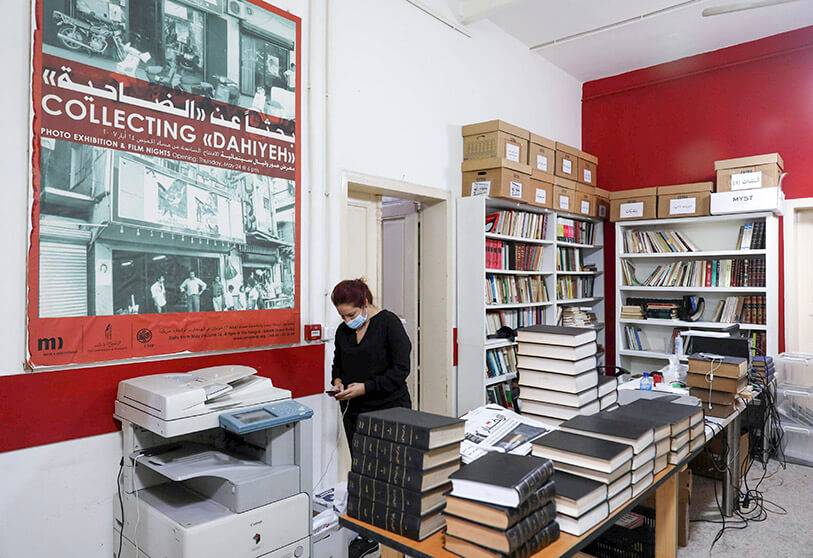 Slim and Borgmann founded Umam Documentation & Research in Haret Hreik. (Credit: Anwar Amro/AFP)
Slim and Borgmann founded Umam Documentation & Research in Haret Hreik. (Credit: Anwar Amro/AFP)
“The ‘Hangar’ was a political decision, a way of saying that ‘Dahieh is not for Hezbollah only,’” Borgmann told L’Orient Today’s sister publication L’Orient-Le Jour.
But Slim’s was not the only cultural project to emerge in Haret Hreik independent of Hezbollah. In 2004, Muhammad Hussein Fadlallah — a prominent Shiite cleric who was often described as a “spiritual mentor” to Hezbollah but had remained autonomous from the group and sometimes at odds with them — had opened his own library, collecting books from around the world, including some that had been banned in Lebanon.
In a 2006 interview with the Washington Post, Fadlallah said that he was against censorship because “you can’t silence an idea by imprisoning it.”
Rebuilding ‘more beautiful than it was’?
In July 2006, in response to a Hezbollah cross-border raid that captured two Israeli soldiers and killed several others, Israel launched a relentless, monthlong bombardment of south Lebanon and Beirut’s southern suburbs that killed more than 1,100 Lebanese, most of them civilians, according to Human Rights Watch.
In Haret Hreik, the bombing brought more than 200 buildings to the ground and displaced some 20,000 people — among them, Farah Nasrallah and her family, whose house was destroyed.
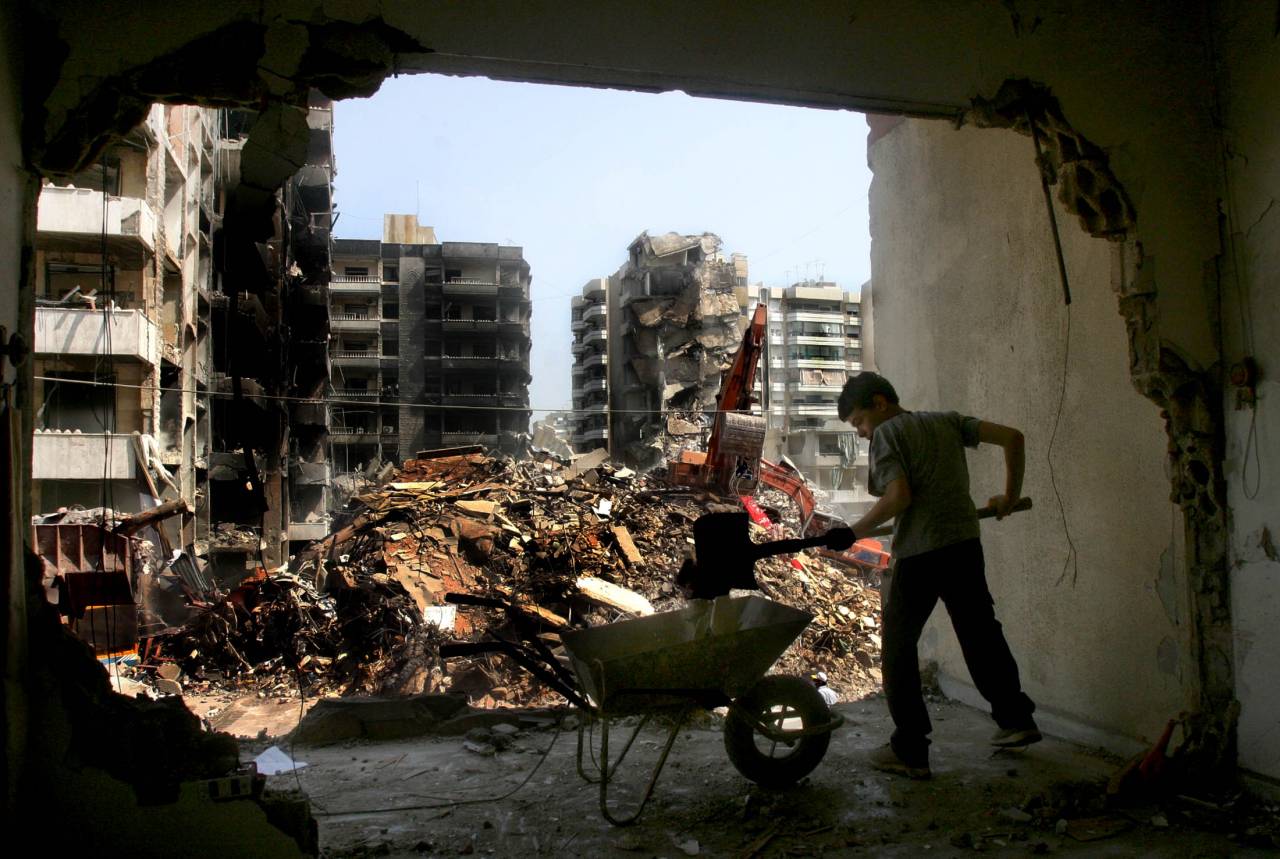 A worker cleans up rubble after Israeli bombing decimated residential areas in 2006. (Credit: Hassan Assal/OLJ)
A worker cleans up rubble after Israeli bombing decimated residential areas in 2006. (Credit: Hassan Assal/OLJ)
In the immediate aftermath of the war, Hezbollah leader Hassan Nasrallah promised to build the area back “more beautiful than it was.” In 2007, the party set up the Waad (“Promise”) agency to carry out the project. Displaced residents were given a choice between waiting for state compensation and rebuilding themselves or signing over their compensation portion to Waad to conduct the work; the vast majority did the latter.
Neither Hezbollah’s media relations office nor former Waad head Hassan Jechi agreed to be interviewed for this piece. But Fawaz noted that the project had come with major challenges; apart from the sheer scale of the destruction, simply sorting out the ownership of each destroyed house was a complex undertaking.
The fact that so many of the structures had been constructed in violation of building codes presented another problem; the 1994 law that regularized many of the illegal buildings had specified that if the building was demolished and rebuilt, it must then follow the rules.
But rebuilding in accordance with codes would have meant a substantial reduction in the number of units available, and thus, permanent displacement for a large number of residents.
“If you have a building that has 12 floors and you can only legally rebuild six, but for 12 floors you have people who have property titles … what do you do with that?” Fawaz said. “For Hezbollah, they could actually rebuild the houses and tell the state to go to hell.”
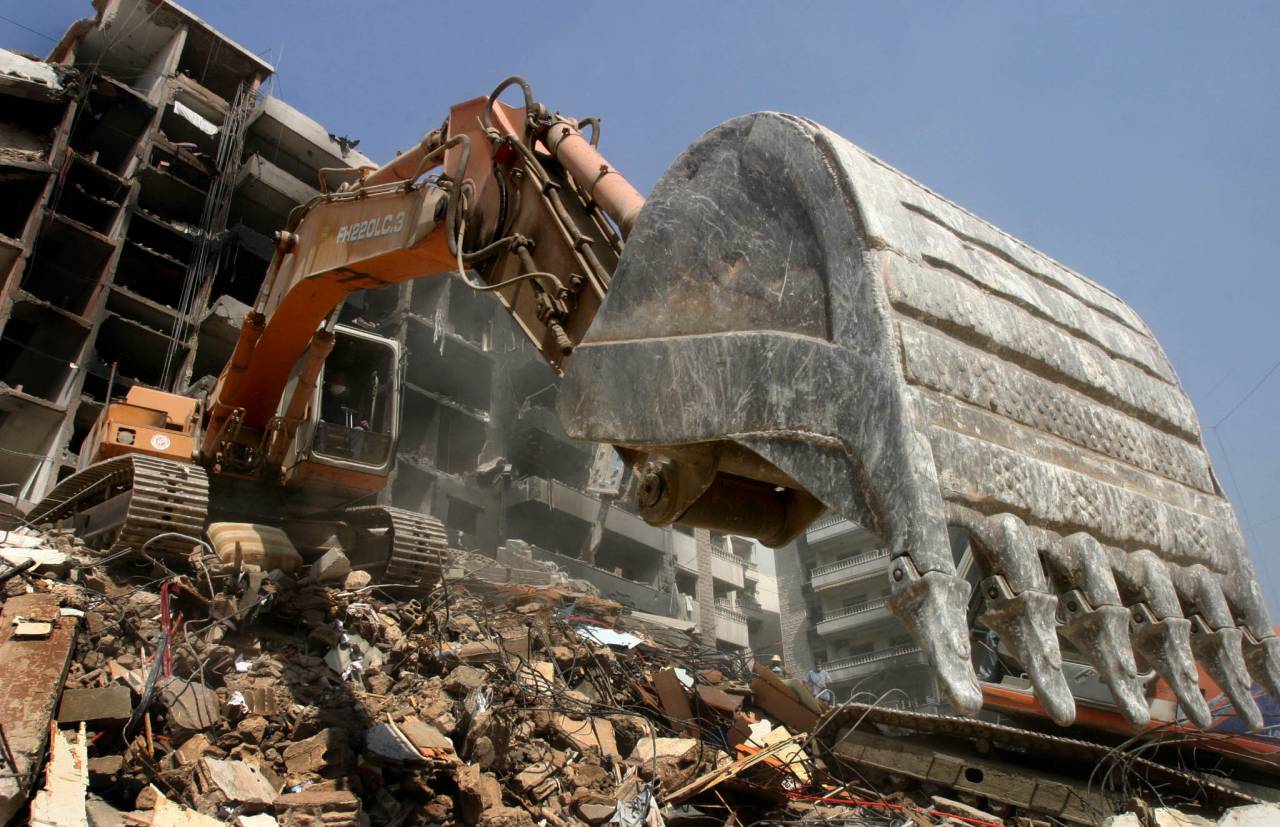 A backhoe at work during postwar clearing and rebuilding. (Credit: Hassan Assal/OLJ)
A backhoe at work during postwar clearing and rebuilding. (Credit: Hassan Assal/OLJ)
The rush to rebuild a carbon copy of what was there before also pushed aside the more participatory planning process some urban planners like Fawaz had called for, including discussions about creating a more livable urban environment with parks and public spaces.
“They really essentially built the exact same volumes with better finishes” and some added amenities like building generators, Fawaz said.
The municipal engineer, Qomati, said that in his opinion, pre-2006 Haret Hreik was “more beautiful than now, because there were fewer buildings and there were more green spaces. You know we don’t have a single public park, not a single one?”
At the same time, Fawaz acknowledged that the project had accomplished its stated purpose of rebuilding quickly and getting people back into their homes, with some 220 buildings reconstructed in less than six years — although there are no reliable statistics regarding how many of the prewar residents actually returned.
“From that perspective, I can’t say they didn't act efficiently,” she said.
A partial reopening
Not all the displaced residents returned after the reconstruction, but Farah Nasrallah’s family was among the ones who did. When they came back to Haret Hreik in 2011 after the reconstruction of their street was completed, the gates and armed guards were gone.
The post-reconstruction era also brought with it a softening of some of the religious and social strictures that had been previously enforced, she said.
“I remember back in the day, if someone played music, they would break his car,” Farah Nasrallah said. Now, not only has the prohibition on music gone away, but the party has turned a blind eye to some practices that directly contradict Islamic principles — like a group of men who set up a poker table on the street below.
She attributed the post-reconstruction change, in part, to an attempt to keep people in the area, and to the fact that by then, Hezbollah had become more entrenched in the formal political system. “They wanted to show another face, that they are open and you can live with them.”
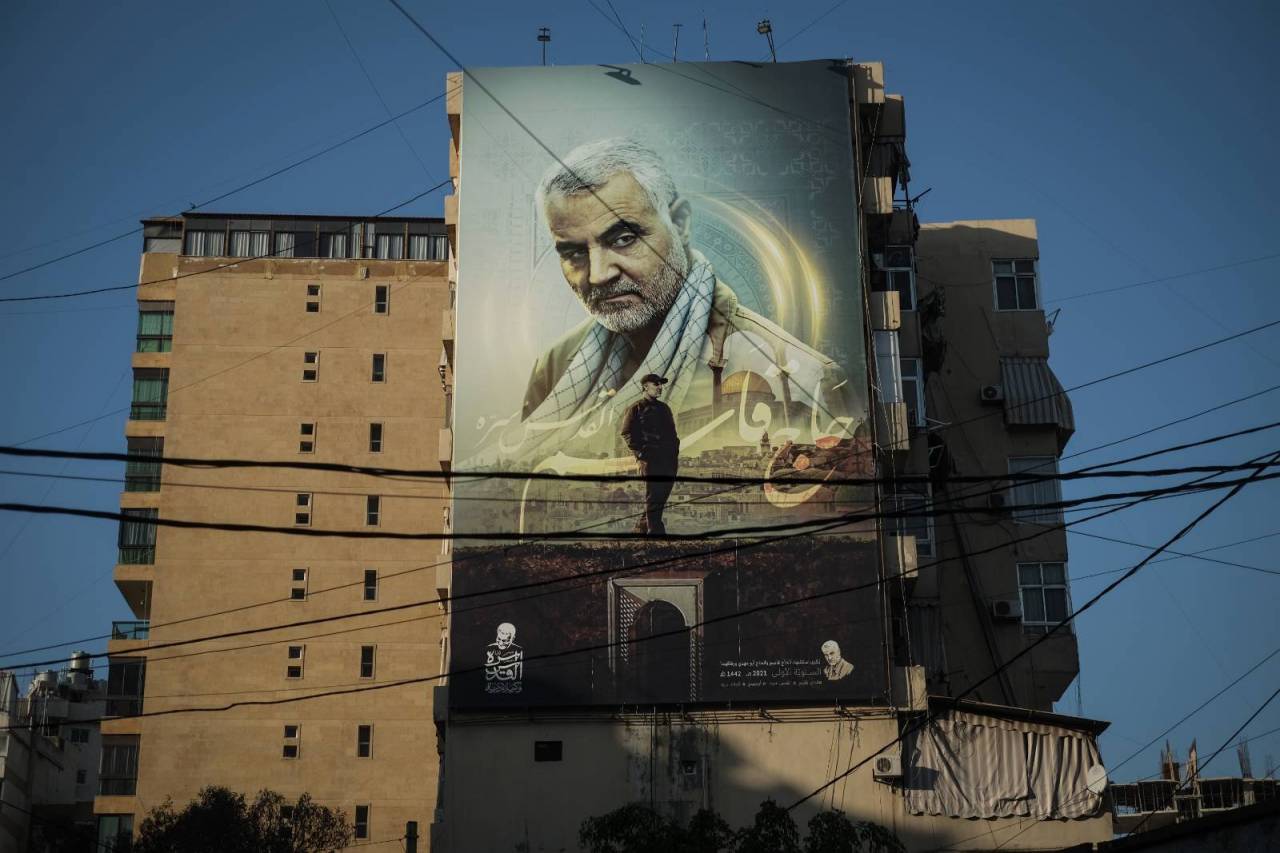 A portrait of Qasem Soleimani, an Iranian general revered by many Hezbollah supporters and assassinated by the United States in 2020, hangs on a building in Haret Hreik. (Credit: João Sousa/L’Orient Today)
A portrait of Qasem Soleimani, an Iranian general revered by many Hezbollah supporters and assassinated by the United States in 2020, hangs on a building in Haret Hreik. (Credit: João Sousa/L’Orient Today)
The relative opening also brought with it a surge in business activity.
“The area changed bit by bit to an area of coffee shops and argileh, tea, mana’ish, sandwiches, but it’s not a touristic area,” Farah Nasrallah said. “They’re businesses for the people of the area.”
Qomati and Waked acknowledged the stigma attached to Haret Hreik, or Dahieh more broadly, but said it is misplaced.
“There is nothing to fear in the area; to the contrary, the area is open to all people,” Waked said, but added, “Of course there are security checkpoints after the explosions that were happening six years ago” when the Syrian civil war threatened to spill over into Lebanon.
Ironically, the most high-profile recent event to draw outsiders to the area was Slim’s funeral. Along with family and friends, the event brought in foreign diplomats, including US Ambassador Dorothy Shea, a Trump appointee who has followed the “maximum pressure” line on Iran and, by extension, Hezbollah. (Even among Hezbollah opponents, her presence was not welcomed by all. “She reinforced what they say about opposition Shiite being with ‘the embassies,’” one opposition activist told L’Orient Today.)
Meanwhile, some in the neighborhood are trying to carve out a space separate from politics.
Among them is the Philosophia Library, a bookshop and cafe that opened in 2019. The project — which was in part inspired by Fadlallah’s library — aimed to provide a kind of cultural salon for the neighborhood’s young people but also to bring people in from outside, co-owner Abbas Fakih told L’Orient Today.
“We opened in Dahieh on purpose,” Fakih said. “We could have gone to Hamra or to Beirut below. … There is a specific stereotype people have about Dahieh, that a lot of people are afraid to enter Dahieh because they think it’s terrorism, thugs — sorry for the word — there is always an ugly picture transposed on Dahieh.”
Jad Hamouch, a university student who joined Fakih in running the shop along with his brother, Ali, a filmmaker, added, “We are proud of something specific and that is that people come from Tripoli, from the Bekaa, from the south, they come from Zahle.”
The aim of the bookshop was also to help in building up a “cultural identity” for the area’s young people, Fakih said, “not just coffee and argileh and sitting around.”
“We wanted to do something cultural, far from all the wars, disagreements, sects,” he said. “People have been waiting, not for us, but for this kind of project, this kind of salon that welcomes everyone.”
